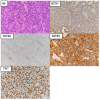Cushing's Disease
- PMID: 31726770
- PMCID: PMC6912360
- DOI: 10.3390/jcm8111951
Cushing's Disease
Abstract
In patients with Cushing's disease (CD), prompt diagnosis and treatment are essential for favorable long-term outcomes, although this remains a challenging task. The differential diagnosis of CD is still difficult in some patients, even with an organized stepwise diagnostic approach. Moreover, despite the use of high-resolution magnetic resonance imaging (MRI) combined with advanced fine sequences, some tumors remain invisible. Surgery, using various surgical approaches for safe maximum tumor removal, still remains the first-line treatment for most patients with CD. Persistent or recurrent CD after unsuccessful surgery requires further treatment, including repeat surgery, medical therapy, radiotherapy, or sometimes, bilateral adrenalectomy. These treatments have their own advantages and disadvantages. However, the most important thing is that this complex disease should be managed by a multidisciplinary team with collaborating experts. In addition, a personalized and individual-based approach is paramount to achieve high success rates while minimizing the occurrence of adverse events and improving the patients' quality of life. Finally, the recent new insights into the pathophysiology of CD at the molecular level are highly anticipated to lead to the introduction of more accurate diagnostic tests and efficacious therapies for this devastating disease in the near future.
Keywords: Cushing’s disease; Cushing’s syndrome; USP-8; aggressive pituitary tumor; pasireotide; pituitary carcinoma; pituitary corticotroph tumor; temozolomide; transsphenoidal surgery.
Conflict of interest statement
The authors have no conflict of interest to disclose.
Figures












References
Publication types
LinkOut - more resources
Full Text Sources
Medical

